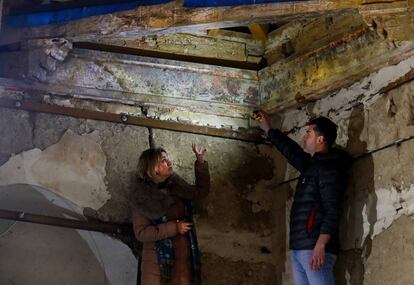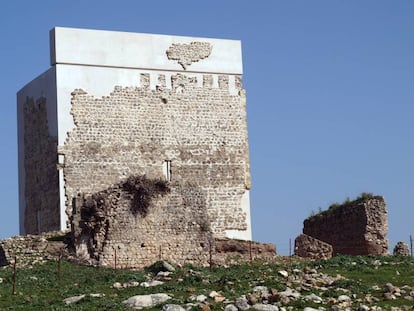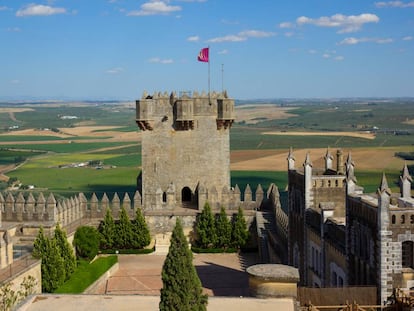The Mudéjar jewel hidden in the palace of the real-life ‘Citizen Kane’
A foundation has discovered that a coffered ceiling belonging to a Spanish church was bought by US magnate William Randolph Hearst and placed in his library

The eccentric American newspaper baron William Randolph Hearst built a vast mansion in California in the middle of the last century, and adorned it with priceless architectural and artistic jewels from across the world.
Such was the extent of the collection amassed by the man on whom Orson Welles partly based his classic film Citizen Kane that the mansion’s architect, Julia Morgan, was not able to use all of it. But she did incorporate the Mudéjar coffered ceiling that was once part of a convent in Cuenca de Campos, in the Tierra de Campos comarca in Spain’s northwestern region of Castile and León, as the Tierra de Campos Restoration Foundation recently discovered. Mudéjar refers to a style of ornamentation developed from the 12th century by the Moors – or Mudéjar – who remained in the south of Spain despite the Christian reconquest.
Chaired by the mayor of Cuenca de Campos, Faustino González Miguel, the foundation was set up in 2017 in a bid to foster economic, social and cultural activity in the region. In April 2018, it acquired the convent of San Bernardino de Siena, which had been used for five centuries by the Poor Clares order of nuns who had inherited it from María Fernández de Velasco, a member of one of the most powerful families of Kingdom of Castile, as shown by her will signed in 1455.
One of the foundation’s first projects was the restoration of the convent. As it is the only monastery from that period built in Castile and León, the foundation had been trying for years to save it from falling into irreversible disrepair.
Once work got underway, the head of the restoration process, Marcos Pérez Maldonado, suggested removing the vaults that remained in the high choir area, given the deterioration of the brickwork there and the extra cost of its refurbishment. Their removal revealed the remains of the old coffered ceiling, which was left behind because taking it would have entailed dismantling the roof and weakening the walls, according to Izaskun Villena, the foundation’s technical director. The remains amount to around two meters of the old coffered wooden ceiling, which is relatively well preserved with the polychrome squares and tiny pieces of tile clearly visible.
The Poor Clare nuns, who landed on hard times, decided to sell the coffered ceiling in 1930 to an antique dealer in Palencia province. Thanks to the proceeds from the sale, the nuns managed to survive in the village until March 1967. At that point, they left Cuenca de Campos taking with them the altarpiece, several treasured paintings and the marble tomb of the aristocrat who had given the order the monastery back in the 15th century. But where had the greater part of the coffered ceiling gone? Members of the foundation launched their own investigation into the matter.

Their first clue came from pediatrician Alfredo Blanco del Val, who put them in contact with history teacher María José Martínez Ruiz, the author of several books, including one co-authored with architect José Miguel Merino de Cáceres called The Destruction of the Spanish Artistic Heritage. W. R. Hearst: “The Great Hoarder,” published by Cátedra in 2012.
As Merino de Cáceres told EL PAÍS, his research in US libraries and archives linked to Hearst led to an inventory of 83 coffered ceilings bought by the tycoon. One of these was acquired on June 20, 1930, by art dealer Arthur Byne, who paid $12,000 (€10,800) for 372 meters of “ceiling and frieze from Campos.” Bingo! This was the key that the foundation had been seeking to unlock the mystery.
The “Campos” that Byne had referred to was more than likely to be Cuenca de Campos. In the winter of 1930, Byne, who died in a traffic accident in Spain in 1935, told Hearst that the coffered ceiling from “Campos” was being sent across the Atlantic, indicating that “it can serve as material for several roofs,” Merino and Martínez explain in their book. Julia Morgan appears to have used part of this coffered ceiling to decorate the roof of the library in Hearst Castle.
Architect Izaskun Villena, director of the Tierra de Campos Restoration Foundation, is convinced that the ceiling is one and the same. “I looked for images of that room on the internet and found elements identical to those that are conserved in the Cuenca de Campos church. A definitive element that totally identifies it as such is, for example, the Fernández de Velasco family’s coat of arms, which is clearly visible,” she explains. “Of course, we have ruled out recovering the coffered ceiling. But one possibility is to make a replica, taking advantage of the workshops we organize at the Tierra de Campos Restoration Foundation,” she says, adding that new members and additional economic support is welcome.
Art and antique warehouse in the Bronx
Part of the coffered ceiling from the San Bernardino convent in Cuenca de Campos is allegedly adorning W. R. Hearst’s extravagant Californian mansion but it doesn’t account for the entire missing portion. So where is the rest?
It is thought it could be languishing in a warehouse that the newspaper magnate owned in the Bronx in New York together with countless other works of art and antiques. According to author José Miguel Merino, it was quite possibly stored there alongside a large chunk of the Cistercian monastery of Sacramenia, Segovia, which was bought by the same art dealer, Arthur Byne, for $40,000 (€36,350), dismantled and taken to New York. In a bid to see if this is true, members of the foundation are planning to travel to the United States in the near future.
Architect Izaskun Villena has already contacted Mary Levkoff, who manages the Hearst Castle, included on the National Register of Historic Places in 1972 and now open to visitors as part of the Californian state’s assets. The hope is to confirm that the Mudejar jewel of Cuenca de Campos lies within and Levkoff and her colleagues are keen to cooperate and get to the bottom of the matter.
English version by Heather Galloway.
Tu suscripción se está usando en otro dispositivo
¿Quieres añadir otro usuario a tu suscripción?
Si continúas leyendo en este dispositivo, no se podrá leer en el otro.
FlechaTu suscripción se está usando en otro dispositivo y solo puedes acceder a EL PAÍS desde un dispositivo a la vez.
Si quieres compartir tu cuenta, cambia tu suscripción a la modalidad Premium, así podrás añadir otro usuario. Cada uno accederá con su propia cuenta de email, lo que os permitirá personalizar vuestra experiencia en EL PAÍS.
¿Tienes una suscripción de empresa? Accede aquí para contratar más cuentas.
En el caso de no saber quién está usando tu cuenta, te recomendamos cambiar tu contraseña aquí.
Si decides continuar compartiendo tu cuenta, este mensaje se mostrará en tu dispositivo y en el de la otra persona que está usando tu cuenta de forma indefinida, afectando a tu experiencia de lectura. Puedes consultar aquí los términos y condiciones de la suscripción digital.
More information
Últimas noticias
Most viewed
- Oona Chaplin: ‘I told James Cameron that I was living in a treehouse and starting a permaculture project with a friend’
- Reinhard Genzel, Nobel laureate in physics: ‘One-minute videos will never give you the truth’
- Sinaloa Cartel war is taking its toll on Los Chapitos
- Why the price of coffee has skyrocketed: from Brazilian plantations to specialty coffee houses
- Silver prices are going crazy: This is what’s fueling the rally










































